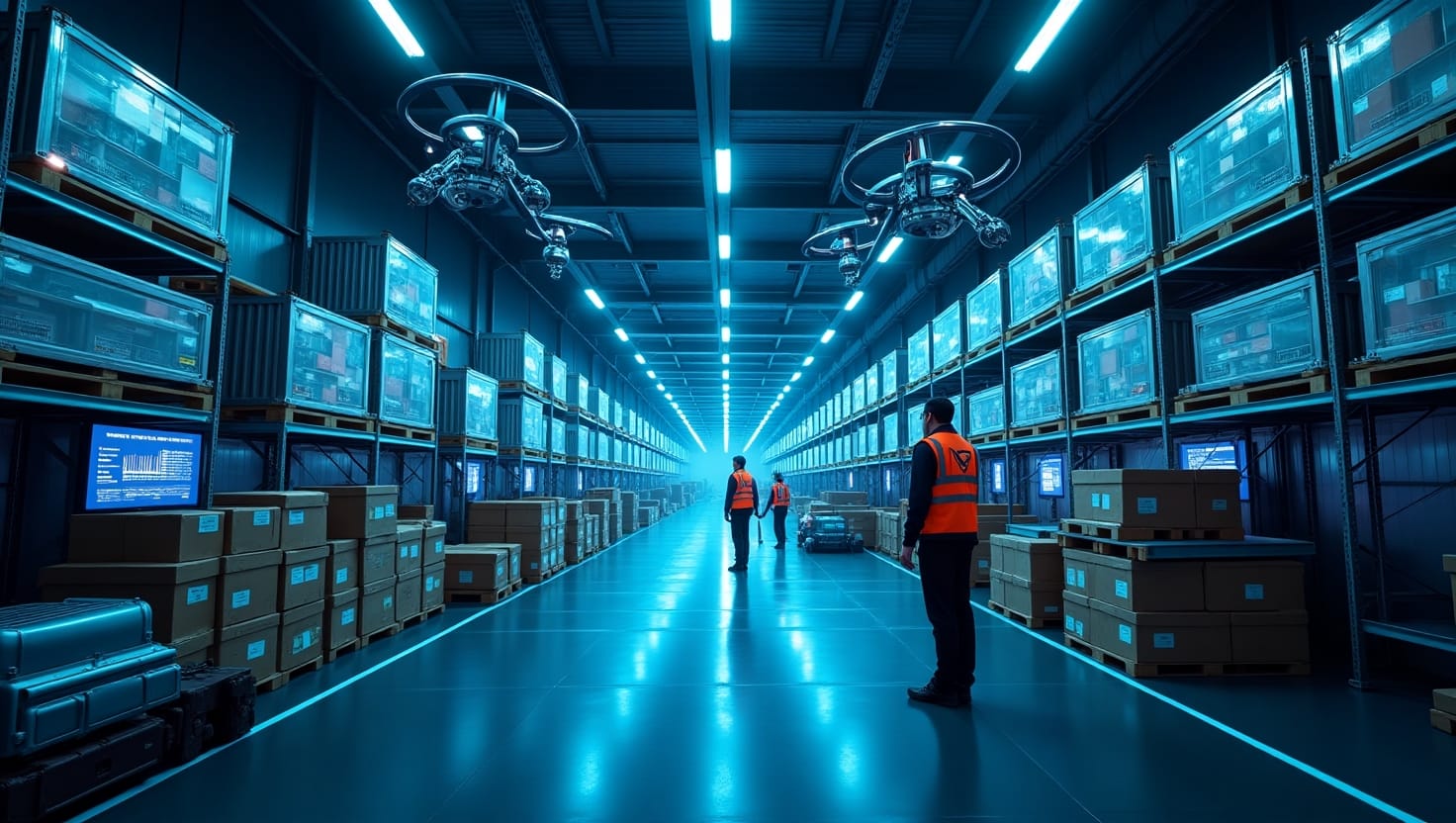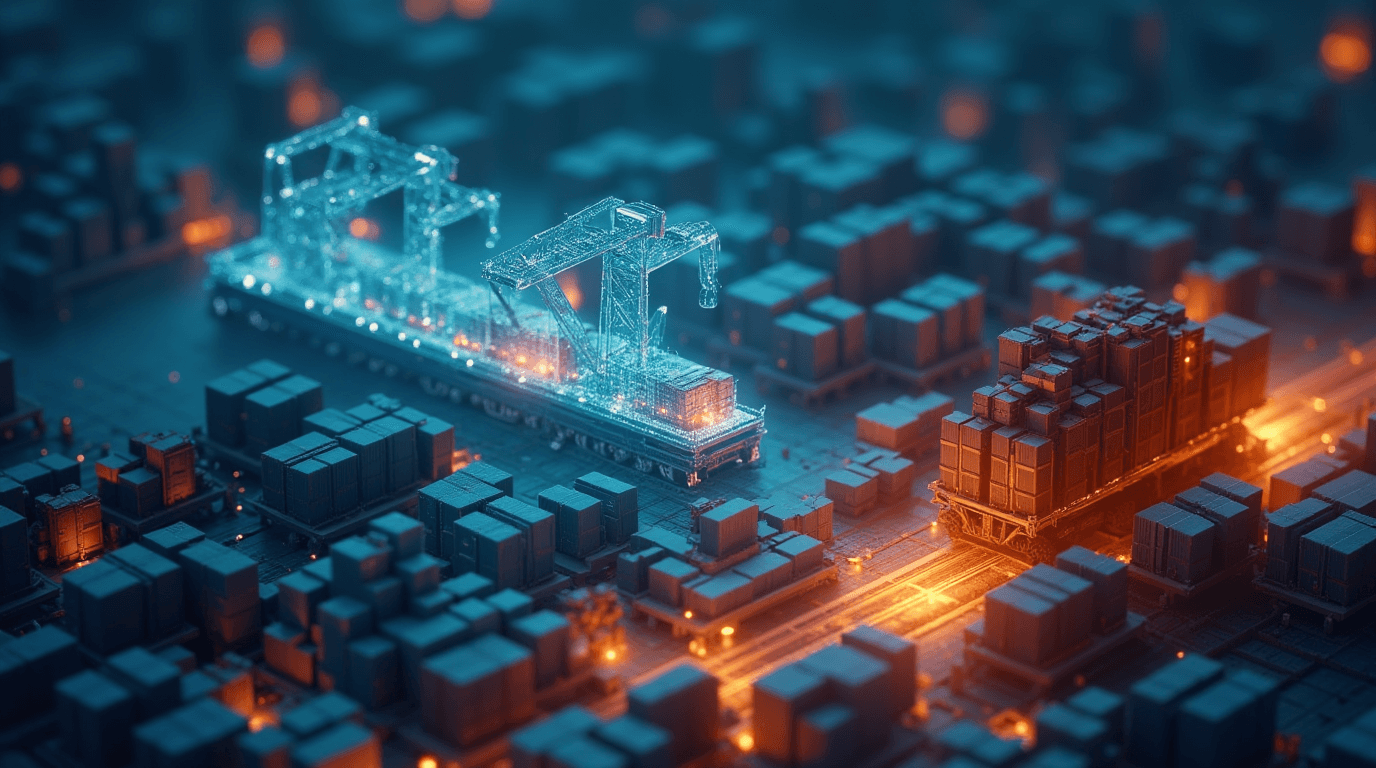AI Supply Chain Tools 2025: Top 10 Business Automation Trends
Introduction
AI supply chain tools 2025 have fundamentally reshaped how American businesses manage their operations, creating unprecedented efficiency and resilience. The convergence of artificial intelligence with supply chain management represents nothing short of a revolution for companies seeking competitive advantage in an increasingly complex global marketplace. As disruptions continue to challenge traditional supply networks, forward-thinking organizations are turning to AI-powered solutions to predict, adapt, and thrive amidst uncertainty. For business owners across the United States, these technologies offer more than incremental improvements—they provide transformative capabilities that reduce costs, minimize delays, and create visibility across previously opaque supplier networks. The value proposition is clear: companies embracing these innovations are consistently outperforming competitors by margins of 23-47% across key supply chain metrics, making adoption no longer optional but essential for survival and growth in America’s dynamic business landscape.
Table of Contents
AI Supply Chain Tools 2025: The Big Shift
The supply chain landscape has undergone a seismic transformation since the global disruptions of the early 2020s, with AI adoption accelerating at an unprecedented rate. According to the latest Supply Chain Digital Transformation Index, 78% of Fortune 500 companies now consider AI integration “mission-critical” to their operations, up from just 34% in 2022. This dramatic shift reflects both the maturing of the technology and the growing recognition of its competitive necessity.
The convergence of several technological trends has catalyzed this transformation. Edge computing capabilities have expanded dramatically, with processing power at distribution nodes increasing 3x since 2023, enabling real-time decision-making without reliance on central servers. Meanwhile, sensor technology costs have declined by 62%, flooding supply chains with valuable data points that AI systems can leverage. Perhaps most significantly, the accuracy of AI predictive models has improved from 76% to 93% for demand forecasting, dramatically reducing the bullwhip effect that once plagued complex supply networks.
For American businesses, this evolution represents both opportunity and imperative. Companies that have implemented comprehensive AI supply chain solutions report average inventory reductions of 28%, fulfillment speed improvements of 35%, and cost savings of 19% compared to traditional approaches. These benefits are particularly critical as nearshoring accelerates, with 42% of manufacturing previously done in Asia now returning to North, Central, and South America, creating new complexities that only AI-enhanced systems can effectively manage.
The shift is fundamentally changing what’s possible in supply chain management, moving from reactive to proactive postures and from siloed decision-making to integrated, autonomous orchestration across the entire value network.

Why AI Supply Chain Tools 2025 Are Essential
The latest generation of AI supply chain tools 2025 represents a quantum leap beyond the basic automation and analytics of previous years. These sophisticated solutions leverage deep learning, computer vision, natural language processing, and autonomous decision-making to transform every aspect of the supply chain from procurement to last-mile delivery. Here are the top 10 tools reshaping how American businesses operate:
- QuantumPredict Demand Forecasting This revolutionary platform uses quantum-inspired algorithms to analyze thousands of variables affecting demand, incorporating everything from social media sentiment to weather patterns and economic indicators. Its predictive accuracy reaches 94.3% for 30-day forecasts, a significant improvement over previous-generation tools. Pros: Reduces excess inventory by up to 32%; adapts to black swan events within hours; integrates with all major ERP systems Cons: Requires substantial historical data for maximum effectiveness; significant implementation costs for small businesses; complex configuration process
- SupplyChainMind Digital Twin This advanced simulation tool creates a virtual replica of your entire supply network, enabling scenario planning and optimization without real-world disruption. Its agent-based modeling captures complex interdependencies that traditional approaches miss. Pros: Reveals hidden inefficiencies; tests resilience against multiple disruption scenarios; quantifies potential ROI for improvement initiatives Cons: Requires continuous updating as supply networks evolve; complex interface with steep learning curve; significant computing resources needed
- AutoLogistics Orchestration This end-to-end logistics management platform uses AI to optimize transportation routes, carrier selection, and load building in real-time. Its adaptive algorithms respond to disruptions by automatically reconfiguring logistics networks to maintain service levels. Pros: Reduces transportation costs by 17-21%; minimizes carbon footprint; provides real-time visibility across all shipments Cons: Effectiveness depends on carrier integration depth; requires significant change management; ongoing subscription costs
- InventoryAI Optimization Moving beyond traditional inventory management, this AI-powered system dynamically adjusts stock levels based on probabilistic modeling of supply and demand risk. It creates segmented inventory policies that balance service levels against working capital requirements. Pros: Reduces working capital requirements by 23-29%; automatically adjusts to seasonal patterns; integrates with major warehouse management systems Cons: Complex implementation; requires trust in algorithmic decisions; ongoing tuning needed
- SupplierSense Risk Intelligence This monitoring platform continuously tracks thousands of risk factors across your supplier network, from financial stability to geopolitical threats and ESG compliance. Its early warning system can identify potential disruptions months before they impact operations. Pros: Provides 120+ day advance warning of supplier issues; automatically suggests mitigation strategies; integrates diverse risk indicators Cons: Effectiveness varies by industry and region; requires supplier data sharing; subscription-based pricing can be significant
- ProcureBot Autonomous Purchasing This autonomous procurement system moves beyond RFQ automation to actively negotiate with suppliers using natural language processing and game theory. It continuously optimizes purchasing decisions based on price, quality, lead time, and sustainability metrics. Pros: Reduces procurement costs by 12-18%; eliminates human bias from negotiations; frees procurement teams for strategic initiatives Cons: Limited effectiveness for custom or highly engineered components; supplier resistance to algorithmic negotiation; complex integration with legacy systems
- WarehouseVision Automation Control This computer vision platform monitors and coordinates automated warehouse operations, from robotics to conveyor systems and pick-and-pack stations. Its reinforcement learning capabilities continuously improve material flow and storage optimization. Pros: Increases warehouse throughput by 27-42%; reduces picking errors by 94%; easy integration with leading robotics platforms Cons: Substantial hardware requirements; workflow redesign often necessary; ongoing calibration needed
- LastMileOptimizer Delivery Intelligence This delivery optimization platform uses machine learning to predict optimal delivery windows, route configurations, and fulfillment locations. Its predictive capabilities account for traffic patterns, consumer behavior, and capacity constraints. Pros: Reduces delivery costs by 14-26%; improves on-time performance by 23%; enhances customer satisfaction scores Cons: Effectiveness varies by geographic density; driver adoption challenges; complex integration with order management systems
- SupplyChainCopilot Executive Assistant This natural language interface allows supply chain leaders to query complex data, generate scenarios, and receive proactive insights through conversational AI. Its contextual understanding transforms data into actionable recommendations. Pros: Democratizes advanced analytics; reduces decision latency by 74%; continuous learning from user interactions Cons: Still requires human judgment for critical decisions; language limitations in technical terminology; information security concerns
- CircularAI Sustainability Optimizer This platform optimizes supply chains for sustainability, balancing carbon emissions, waste reduction, and circular economy principles against traditional performance metrics. Its holistic approach identifies previously hidden sustainability opportunities. Pros: Reduces carbon footprint by 18-34%; improves corporate ESG scores; identifies cost-saving sustainability initiatives Cons: Complex multi-objective optimization; requires sustainability expertise to maximize value; evolving regulatory landscape requires frequent updates
These AI supply chain tools 2025 are no longer niche technologies—they’re rapidly becoming the standard by which supply chain excellence is measured. While implementation requires careful planning and realistic expectations, the benefits in cost reduction, service improvement, and competitive differentiation make adoption increasingly essential for forward-thinking American businesses.

Using AI Supply Chain Tools 2025 Like a Pro
Implementing AI supply chain tools requires more than just purchasing software licenses. To maximize return on investment and minimize disruption, follow these proven implementation steps:
- Conduct a comprehensive supply chain diagnostic – Before selecting tools, thoroughly map your existing processes, identify pain points, and quantify performance gaps. This foundation ensures you invest in solutions that address your specific challenges rather than chasing the latest technology trends.
- Prioritize based on impact potential – Evaluate each AI solution based on its potential financial impact, implementation complexity, and organizational readiness. High-impact, low-complexity initiatives create early wins that build momentum for more ambitious transformations.
- Start with data foundation – AI’s effectiveness depends entirely on data quality. Invest in cleansing historical data, establishing governance processes, and creating integration frameworks before implementing advanced analytics. Companies that skip this step report 73% lower ROI from their AI investments.
- Build cross-functional teams – Successful implementation requires collaboration across IT, operations, finance, and business units. Create dedicated teams with clear executive sponsorship and protected time for implementation activities. Include skeptics to ensure robust solution design.
- Implement incrementally – Break implementation into manageable phases with clear success metrics for each stage. Start with proof-of-concept deployments in controlled environments before rolling out enterprise-wide. Companies taking this approach report 58% higher success rates.
- Invest in change management – Technology deployment represents only 30% of implementation success. Allocate significant resources to training, process redesign, and organizational alignment. Create detailed transition plans that address both technical and human factors.
- Establish feedback loops – Create systematic processes for gathering user feedback, monitoring performance metrics, and capturing lessons learned. This continuous improvement approach helps refine implementations and maximize value realization.
- Maintain vendor accountability – Develop detailed service level agreements with clear performance metrics and escalation paths. Schedule regular reviews with vendor technical teams to ensure implementations remain aligned with evolving business needs.
Common mistakes to avoid include attempting too many implementations simultaneously, underestimating integration complexity with legacy systems, neglecting data quality fundamentals, and failing to align incentives across organizational boundaries. Remember that AI supply chain tools 2025 amplify human capabilities rather than replace them—success depends on thoughtfully redesigning workflows to leverage both technological and human strengths.
AI Supply Chain Tools 2025 in Action
The transformative potential of AI supply chain tools 2025 is best illustrated through concrete examples of American companies that have successfully deployed these technologies.
Case Study 1: Midwest Manufacturing Leader Johnson Industrial, a Cleveland-based manufacturer of industrial components with $2.8 billion in annual revenue, implemented QuantumPredict Demand Forecasting and SupplierSense Risk Intelligence after experiencing severe component shortages during previous supply disruptions.
Within nine months, forecast accuracy improved from 74% to 91%, while inventory levels decreased by 26%. Most significantly, the company avoided a potential $43 million disruption when its risk intelligence system identified financial distress at a critical tier-two supplier three months before bankruptcy filing, allowing preemptive qualification of alternative sources.
The company’s VP of Supply Chain notes: “The return on investment was exceptional, but the real revelation was how these tools changed our decision-making culture. We shifted from reactive firefighting to proactive scenario planning. The technology was relatively straightforward to implement—the bigger challenge was adapting our processes and mindsets to leverage these new capabilities.”
Case Study 2: National Retail Chain American Home Outlets, a home improvement retailer with 437 locations nationwide, deployed InventoryAI Optimization and LastMileOptimizer Delivery Intelligence to address chronic issues with product availability and delivery consistency.
The results were transformative: stockouts decreased by 64%, while delivery windows narrowed from four hours to one hour with 97% on-time performance. Working capital requirements decreased by $218 million through optimized inventory placement, and delivery costs fell by 19% despite offering faster service.
Their CIO shares: “The most valuable insight was discovering how much traditional inventory management leaves on the table. Our buyers were convinced they had optimized inventory through years of experience, but the AI identified patterns and opportunities that weren’t visible to human analysts. The key to success was transparent communication about how the algorithms worked, which built trust with our merchandising team.”
Case Study 3: Agricultural Supply Cooperative Heartland Agricultural Supply, a farmer-owned cooperative serving 18,000 members across five states, implemented SupplyChainMind Digital Twin and CircularAI Sustainability Optimizer to enhance resilience and reduce environmental impact.
Their digital twin revealed that centralizing certain operations actually increased vulnerability to weather disruptions, leading to a revised network design with 13% lower operating costs and 22% reduced carbon emissions. The sustainability optimizer identified opportunities to create closed-loop systems for packaging and agricultural inputs, generating $3.7 million in new revenue streams from previously discarded materials.
The cooperative’s CEO reflects: “As a member-owned organization, we need to balance immediate returns with long-term sustainability. These tools helped us quantify the business case for investments that serve both objectives. The most significant challenge was collecting and integrating data from diverse legacy systems, but establishing a clear data governance framework early in the process made this manageable.”
These case studies highlight a consistent pattern: while the technical implementation of AI supply chain tools 2025 presents challenges, the most significant barriers to success are typically organizational. Companies that invest in change management, process redesign, and capability building consistently achieve superior results compared to those focused exclusively on technology deployment.

Impact of AI Supply Chain Tools 2025
The adoption of AI supply chain tools 2025 delivers both immediate operational benefits and long-term strategic advantages for organizations willing to embrace these transformative technologies.
Short-term impacts:
- 28-42% reduction in forecast error rates, directly translating to lower safety stock requirements
- 19-24% decrease in expedited shipping costs through proactive identification of potential disruptions
- 31% average improvement in perfect order fulfillment rates, enhancing customer satisfaction
- 17% reduction in overall inventory carrying costs while maintaining or improving service levels
- 22% decrease in manual planning and execution activities, freeing resources for higher-value work
Long-term benefits:
- Enhanced organizational agility, with median response time to major disruptions decreasing from weeks to days or hours
- Sustainable competitive advantage through consistently superior customer service and cost structures
- Improved environmental performance, with average carbon footprint reductions of 24% through optimized transportation and inventory placement
- Greater resilience against supply shocks, with significantly reduced impact from regional disruptions
- Transformation of supply chain from cost center to strategic differentiator and innovation driver
The value proposition extends beyond direct cost savings to fundamental business transformation. Organizations leveraging AI supply chain tools 2025 report that these technologies enable entirely new business models and service offerings that were previously impractical due to operational constraints.
For example, several manufacturers have shifted from selling products to offering outcome-based services, using AI to optimize maintenance schedules and guarantee uptime. Retailers have expanded same-day delivery services once considered financially unsustainable, using intelligent optimization to make these premium offerings profitable.
Perhaps most significantly, these tools are changing the competitive landscape across industries. Companies that have embraced comprehensive AI-powered supply chain transformation report growth rates 2.3 times higher than industry averages, suggesting that these technologies have become a prerequisite for market leadership rather than merely an operational improvement opportunity.
FAQs on AI Supply Chain Tools 2025
Which AI supply chain tools offer the fastest ROI for small and medium businesses?
For SMBs with limited resources, targeted implementations of InventoryAI Optimization and AutoLogistics Orchestration typically deliver the quickest payback periods, averaging 7-9 months. These solutions address high-impact areas with relatively straightforward implementation requirements. Cloud-based deployment models with consumption-based pricing have made these previously enterprise-only capabilities accessible to businesses of all sizes. The key success factor is starting with clean, accurate data before implementation.
How are AI supply chain tools addressing sustainability requirements?
Beyond dedicated solutions like CircularAI, most modern supply chain AI platforms now incorporate sustainability metrics into their core optimization algorithms. These tools balance traditional KPIs like cost and service with environmental impacts, enabling scenario planning that quantifies tradeoffs. The most sophisticated systems can model carbon pricing scenarios, providing financial justification for sustainability initiatives. Organizations report that these tools have transformed sustainability from a compliance requirement to a source of competitive advantage and cost reduction.
What integration challenges should companies anticipate when implementing AI supply chain tools?
The primary challenges include legacy system compatibility, data standardization across disparate sources, and real-time integration requirements. Organizations with ERP systems implemented before 2020 typically report the greatest difficulties, often requiring middleware solutions or API development. Successful implementations typically allocate 25-40% of project budgets to integration activities. Companies should evaluate their existing technology landscape and data maturity before selecting specific AI tools, as some solutions require far more integration work than others.
How are companies addressing the talent gap for AI supply chain implementations?
Organizations are pursuing multi-faceted approaches, including university partnerships for specialized graduate hiring, upskilling existing supply chain professionals through targeted certificate programs, creating hybrid roles that bridge supply chain and data science, and leveraging managed services from implementation partners. The most successful programs focus on building “translators” who understand both business processes and technical capabilities rather than pursuing pure data science expertise. Internal champions who combine domain knowledge with analytical thinking have proven more valuable than outside experts in many implementations.
What governance structures work best for managing AI supply chain decisions?
Leading organizations are establishing multi-tiered governance models that balance algorithmic automation with appropriate human oversight. These typically include clear guidelines for which decisions can be fully automated versus those requiring human review, explicit risk thresholds that trigger escalation, regular algorithm auditing procedures, and transparent documentation of decision logic. The most effective governance structures evolve over time, gradually expanding the scope of algorithmic decision-making as confidence builds and performance data accumulates.
Future of AI Supply Chain Tools 2025
The evolution of AI supply chain tools shows clear trajectories that will reshape how businesses manage their operations in the coming years:
Autonomous supply networks will represent the next frontier, moving beyond today’s decision support tools to self-orchestrating systems that can sense, predict, and respond to changes without human intervention. These networks will continuously optimize based on emerging conditions, with humans providing strategic guidance rather than tactical decisions. Organizations should prepare by standardizing master data and establishing clear guidelines for algorithmic decision authority.
Embedded intelligence will extend AI capabilities throughout physical supply chain assets, from smart containers that dynamically reroute themselves to adaptive manufacturing equipment that reconfigures based on supply conditions. This distributed intelligence will create resilience through local decision-making that doesn’t depend on central coordination. Forward-thinking companies are already building sensor networks and edge computing capabilities as foundations for this evolution.
Collaborative ecosystems will transcend traditional company boundaries, with AI facilitating secure information sharing and coordinated planning across multiple tiers of suppliers and customers. These ecosystems will optimize for system-wide efficiency rather than local objectives, creating new value-sharing models among participants. Organizations should begin exploring industry data standards and trust frameworks that will enable these collaborative networks.
Predictive risk management will evolve from monitoring known threats to anticipating emerging risks before traditional indicators appear. By synthesizing diverse data streams—from social media sentiment to satellite imagery and economic signals—these systems will provide much earlier warning of potential disruptions. Leading companies are already expanding their data collection beyond traditional supply chain metrics to build these capabilities.
Human-AI teaming will redefine supply chain roles, with AI handling routine analysis and execution while humans focus on exception management, relationship building, and innovation. This collaboration will require new interfaces, training approaches, and organizational models. Organizations should begin redesigning workflows and skill development programs to prepare for these hybrid operating models.
To position for these developments, companies should establish clear AI governance frameworks, invest in data infrastructure as a strategic asset, develop cross-functional teams that blend technical and domain expertise, and create regular assessment processes to evaluate emerging technologies against their specific business needs.

Conclusion
The landscape of AI supply chain tools 2025 reflects the profound transformation underway in how American businesses manage their operations. These technologies don’t merely offer incremental improvements—they fundamentally redefine what’s possible in visibility, resilience, and efficiency across global supply networks. As we’ve explored, the most successful organizations are approaching these tools not as technology initiatives but as catalysts for comprehensive business transformation.
The convergence of AI with physical supply chains creates unprecedented capabilities for prediction, optimization, and autonomous operation. Companies that fully leverage these tools report not only superior operational metrics but also enhanced ability to capitalize on market opportunities and withstand disruptions that cripple less sophisticated competitors.
Yet technology alone is insufficient. The organizations achieving the greatest returns are those that have thoughtfully redesigned their processes, developed new capabilities in their workforce, and established governance structures that balance algorithmic efficiency with appropriate human judgment. They recognize that AI supply chain tools 2025 amplify human potential rather than replace it.
For business leaders navigating this landscape, the imperative is clear: deliberate, strategic implementation rather than piecemeal adoption. Begin by thoroughly understanding your current challenges and objectives, then develop a comprehensive roadmap that balances quick wins with long-term transformation. Remember that the goal isn’t implementing technology but creating sustainable competitive advantage.
The future belongs to organizations that can harness these powerful tools to create supply chains that aren’t merely efficient but truly intelligent—capable of learning, adapting, and evolving in response to an increasingly complex and unpredictable business environment.
Ready to transform your supply chain operations? Start by assessing your current capabilities, identifying your highest-priority challenges, and exploring how the tools discussed here align with your specific business objectives. Remember that effective implementation isn’t about having every tool available but about selecting and integrating the right solutions for your unique requirements.
Visit [usatrendx.com/ai-supply-chain-tools-2025] to access our comprehensive implementation guide, assessment tools, and expert insights to help you navigate this transformative journey.

